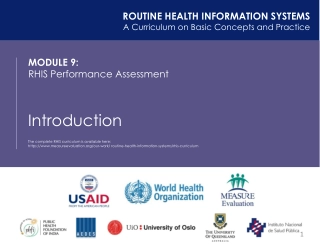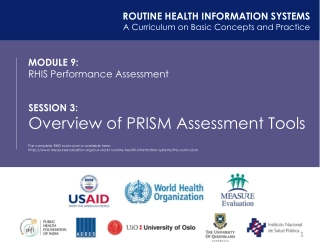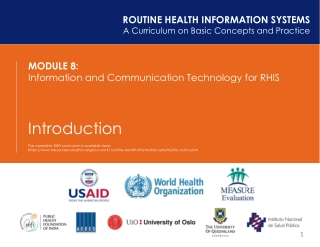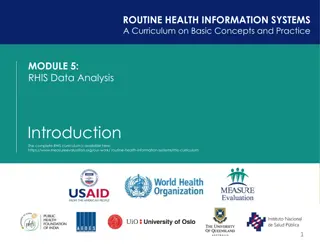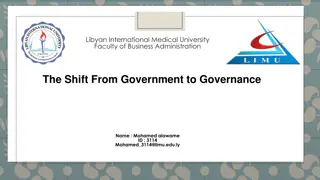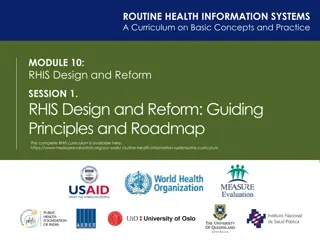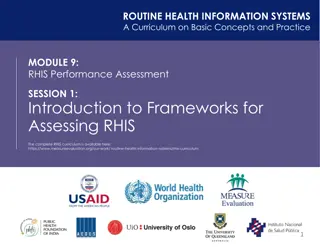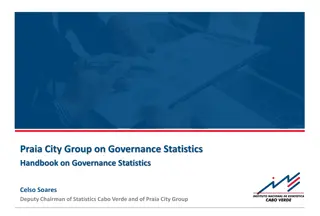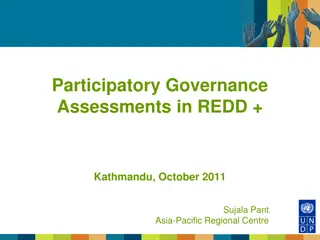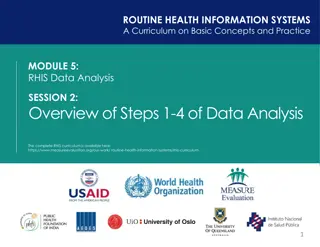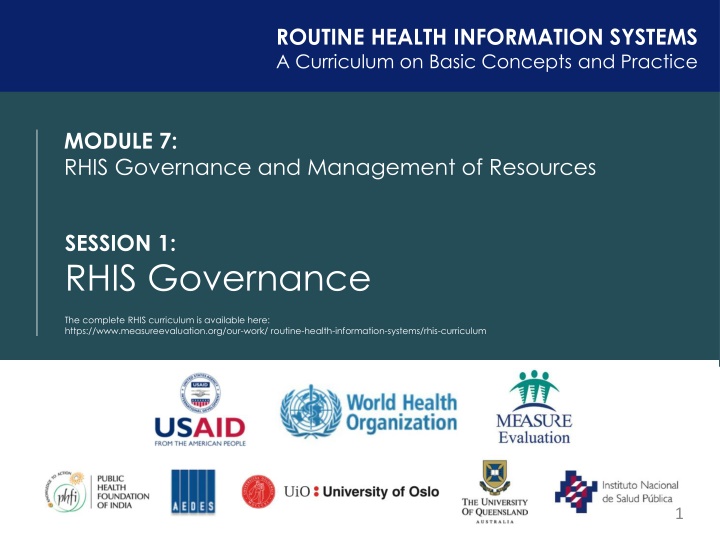
RHIS Governance: Concepts & Practice
This module delves into the governance and management aspects of Routine Health Information Systems (RHIS), covering topics such as governance functions, tools, indicators, and the link between health services systems and RHIS. It also discusses the distinction between centralized and decentralized health systems, emphasizing the importance of governance in the public sector.
Download Presentation

Please find below an Image/Link to download the presentation.
The content on the website is provided AS IS for your information and personal use only. It may not be sold, licensed, or shared on other websites without obtaining consent from the author. If you encounter any issues during the download, it is possible that the publisher has removed the file from their server.
You are allowed to download the files provided on this website for personal or commercial use, subject to the condition that they are used lawfully. All files are the property of their respective owners.
The content on the website is provided AS IS for your information and personal use only. It may not be sold, licensed, or shared on other websites without obtaining consent from the author.
E N D
Presentation Transcript
ROUTINE HEALTH INFORMATION SYSTEMS A Curriculum on Basic Concepts and Practice MODULE 7: RHIS Governance and Management of Resources SESSION 1: RHIS Governance The complete RHIS curriculum is available here: https://www.measureevaluation.org/our-work/ routine-health-information-systems/rhis-curriculum 1
Session1: Learning Objectives and Topics Covered Learning Objectives: Understand the overall concept of governance and governance functions Relate governance concepts to HIS and RHIS governance Topics: Definition and examples of governance Governance functions Tools of governance Governance indicators 2
Overview of Health Services System and Links with Country s Governance System Health services system structure and the close link with the RHIS Centralized versus decentralized health system 3
Close Link between Health Services System and RHIS HEALTH CARE LEVEL Community Level CATCHMENT AREA POPULATION Patient/Client contact First level care unit PRIMARY District Health Management Team DISTRICT LEVEL Referred patients District Hospital SECONDARY Regional Health Mgmt Team Referred patients REGIONAL LEVEL Regional Hospital TERTIARY Ministry of Health Universities Other Health Institutions National Hospital NATIONAL LEVEL Referred patients University Hospital OTHER SECTORS: -Environment -Civil Administr. -Transport -Education INDIVIDUAL CARE MANANAGEMENT SYSTEM MANAGEMENT HEALTH UNIT MANAGEMENT Routine Health Information System HEALTH CARE SERVICES HEALTH SERVICES SYSTEM HEALTH SYSTEM 4
Centralized Versus Decentralized Health System DEGREE OF DECENTRALIZATION Deconcentration Delegation Devolution Privatization 5
Definition of Governance in Health and HIS/RHIS Recognition of the importance of governance in public sectors is a recent phenomenon. Many definitions of governance in health have emerged. We will discuss examples of governance that influence and support the HIS and RHIS. Many governance functions pertain to the national HIS as well as the RHIS. o Therefore, here we ll use the term HIS/RHIS. Governance tools list Give examples of HIS/RHIS governance tools in your country 6
HIS/RHIS Governance Key Concepts and Functions HIS/RHIS Policy and Strategic Planning HIS/RHIS Regulatory and Legal Framework and Legislation Promoting HIS/RHIS Accountability and Transparency Fostering Partnerships and Coordination Organizational Structure of HIS/RHIS 7
HIS/RHIS Policy and Strategic Planning An HIS/RHIS policy is a document that refers to decisions, plans, and actions undertaken to achieve specific HIS/RHIS development objectives, strategies, and results. HIS strategic plans are mostly for 5 to 10 years and can take 3 to 6 months to develop. They include operational costed plans for 1 or 2 years. HIS/RHIS policy and strategic planning are often combined in one document 8
HIS Strategic Planning and Design Process in Twelve Steps Phase 1 Phase 2 Priority-setting and Planning Phase 3 Planning Module I Preparing for Strategic Planning Planning Module II Conducting HIS Strategic Planning Planning Module III Detailed HIS Planning and Costing Leadership, Coordination, and Assessment Implementation Organize the HIS Planning Groups Steering Committee, Core Team, HIS Stakeholder WG 4. Priority HIS Components and Problems 9. Detailed Strategy and Operational Plan 1. Review HIS Assessment Results HIS Assessment 5. The HIS Vision Commence Implementation 6. Ongoing & Planned HIS Strengthening Efforts 10. Strategy Costing 2. Review Health System Development Priorities and define HIS Problems Commence monitoring and evaluation 11. HIS M&E Plan 7. HIS Objectives and Interventions Inventory On-going HIS strengthening Efforts Reprogram ming as necessary 12. HIS Strategic Plan Document 9 8. Intervention Implementation Phasing Green steps are carried out by the SWG, blue steps by the CT or small working groups
Exercise: HIS Policy and Strategic Planning See the handout HIS Strategic Planning in Afghanistan. Read the case study (15 minutes). Discuss in small groups and list some lessons learned based on the observations of the technical advisor (p.10 of the handout) and based on your own country experience (20 minutes). Plenary discussion (10 minutes) 10
HIS/RHIS Legal and Regulatory Framework and Legislation Examples of HIS/RHIS related regulations and legislation Functions and categories of HIS/RHIS regulations Implications, benefits, and risks of HIS/RHIS legislation and regulations Exercise on HIS/RHIS regulation and legislation 11
Promoting HIS/RHIS Accountability and Transparency Examples of HIS/RHIS performance and development as possible subjects for accountability Types of accountability and levels of implementation Methods to increase accountability of health system units, departments, managers, and staff for proper RHIS operations, management, and use. Requirements for enforcing HIS/RHIS transparency and accountability Benefits of HIS/RHIS transparency and accountability 12
Exercise on HIS/RHIS Accountability Working in small groups, please discuss the concept of HIS/RHIS accountability and its relationship to development and performance. First, review, discuss, and possibly expand the list of examples of HIS/RHIS performance and development presented in Section 1 of the handout Examples of RHIS Accountability and Transparency. Then review, discuss, and possibly expand the lists shown in Sections 2 (A, B, and C), and 3 of the same handout: Types of accountability Relevant system levels, where accountability is felt to exist Examples of methods/indicators for monitoring/assessing fulfillment of accountability Examples of the use of transparency to foster and benefit from adequate HIS/RHIS performance and accountability 13
Exercise on HIS/RHIS Accountability (Continued) Next, please work with your subgroup to select 2 4 examples of HIS/RHIS performance and development for which the form in the handout Exercise on Accountability and Transparency could be completed. 14
Fostering HIS/RHIS Partnership and Coordination Coordination and maintenance of collaborative partnerships are critical factors for the development of health-information systems, and for the effective operation and sustainability of important routine health information system/health information system (HIS/RHIS) functions. Examples of approaches to HIS/RHIS coordination and collaboration Leadership is another critical factor: no functional sustainable HIS/RHIS without a CHAMPION 15
Exercise on Partnership and Coordination Participants work in small groups for 30 minutes. Identify HIS/RHIS performance subjects that need partnership and collaboration in Section 1 of the handout Examples of Accountability and Transparency, based on your experience. Present examples in plenary discussion. 16
HIS/RHIS Organization Principles and Structural Considerations How are common national HIS subsystems and functions structurally organized and linked? What are common HIS organizational principles and practices to consider, and what are pitfalls to avoid? 17
ROUTINE HEALTH INFORMATION SYSTEMS A Curriculum on Basic Concepts and Practice This presentation was produced with the support of the United States Agency for International Development (USAID) under the terms of MEASURE Evaluation cooperative agreement AID-OAA-L-14-00004. MEASURE Evaluation is implemented by the Carolina Population Center, University of North Carolina at Chapel Hill in partnership with ICF International; John Snow, Inc.; Management Sciences for Health; Palladium; and Tulane University. The views expressed in this presentation do not necessarily reflect the views of USAID or the United States government. 18


